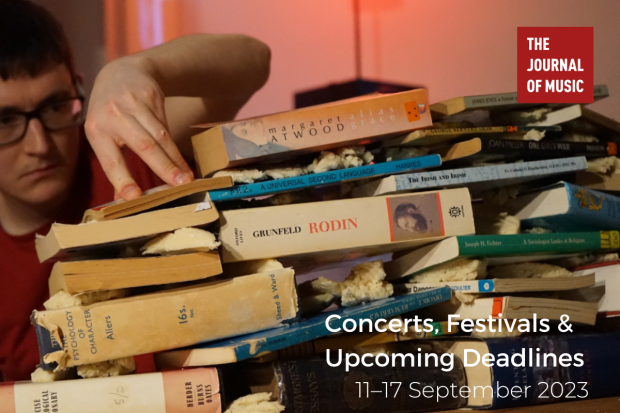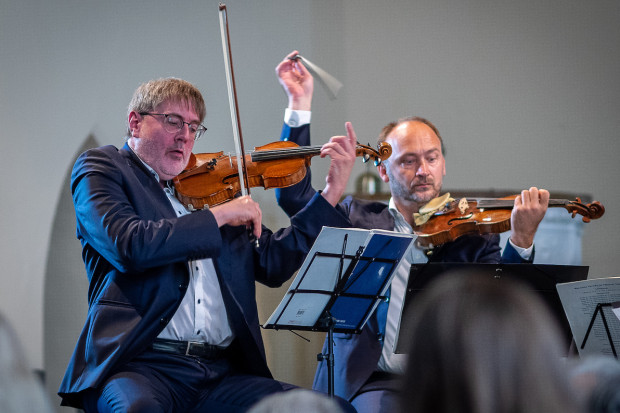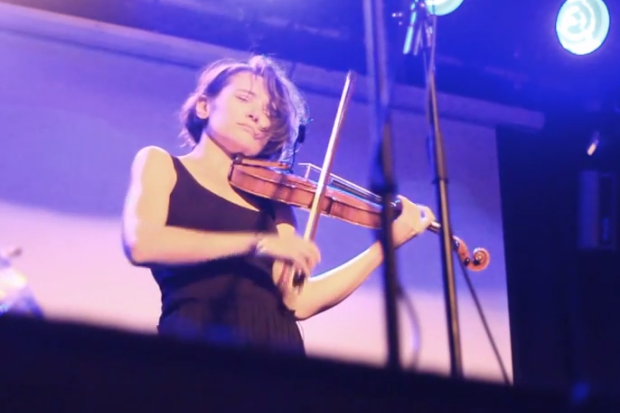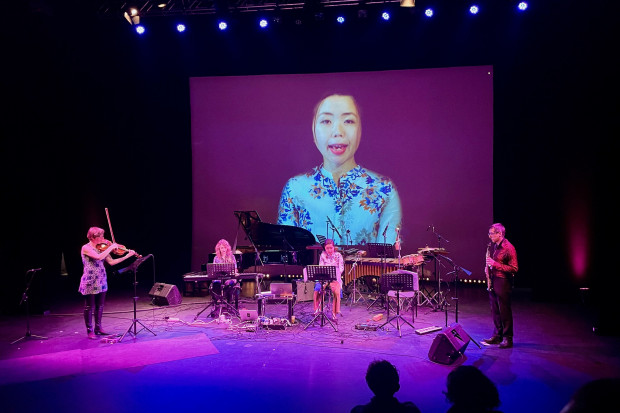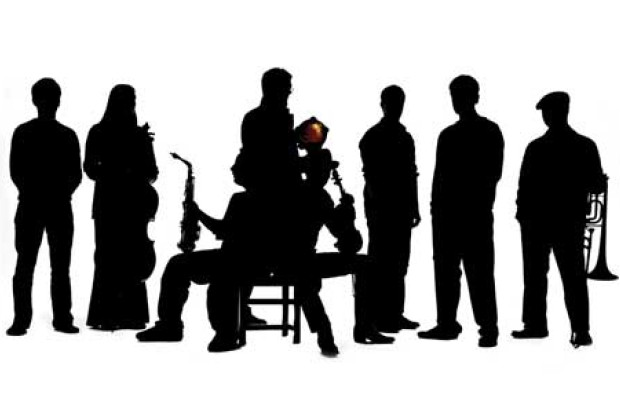
Lianne Quigley and Jane Hackett performing in 'The Body that Breathes' at Unit 44 (Photo: Sanda Sameika)
Never Taking Communication for Granted
It is tempting to think that Kirkos Ensemble’s venue space – Unit 44 on Prussia Street in Stoneybatter, Dublin – is not ideal as a performance space because its single-pane glass front only poorly muffles passing sound. But Kirkos has never been known to let a problem go to waste, and this thin window was emblematic of Jane Hackett’s The Body that Breathes concert experience on 1 and 2 November, which the violinist created in collaboration with composer George Higgs and the Dublin Theatre of the Deaf.
As if drawing attention to the partialness of the barrier window, the concert actually starts outside. When the concert began with Adrian Hart and Hackett’s Sounding, the audience was still stood outside in the cold. The security shutters rolled up to the sight of silhouetted dancers against the glass, with Hackett’s violin just about audible. We were invited to touch the window, the dancers’ movements against the glass turning it into not just a barrier but a medium, one through which their movements could be heard (for what we hear, when we hear, is vibration). But though a medium, it was still a barrier: for though we could hear what would be entirely inaudible but for the dancers’ contact with the window, what we heard was nevertheless a representation lacking detail.
In performing music that was almost inaudible and which could best be experienced through touch, the audience began already to get a glimpse of how seriously the concert experience was both for Deaf and hearing audiences. The seriousness was maintained as we filed in to the building: we were invited to lay our hands on a large balloon resting atop a speaker whose vibrations – sound – were transferred by the balloon to our hands. We were then each given a small balloon to hold throughout the concert. Balloons, like speaker diaphragms, efficiently translate air vibrations into vibrations our hands can feel – or hear – but do so imperfectly: high pitches were not transferred at all, those pitches that were transferred often lost a lot of their individuality (though some gong sounds created wonderful effects), and the balloons add their own squeaky life to the transmission too. This imperfection was the point, though, I think: a representation of the imperfection of translation, or of the incorrigibly different experiences Deaf and hearing audiences had of the concert.
Invisible language
The second work, Andy Ingamells and Maya Verlaak’s Tape Piece, started once the audience was seated along the two side walls of the room. The eponymous ‘tape’ was pointedly not magnetic audio tape, though, but masking tape and Sellotape. The piece is superficially simple: the six performers (Hackett and Higgs as well as Lianne Quigley, Alvean Jones, Lucia Kickham, Aoibhinn O’Dea and Lara Gallagher), in pairs, taped each other to each other before, more arduously, tearing themselves apart again. But it was rich: Jones and Quigley first wrapped each other’s hands – their speaking organs – together, making of the tape a bond both in the sense of something that brings together and something that constricts. It was striking, too, that the translucent Sellotape one couple used was so much stronger than the more visible masking tape the others used. I wondered again about how invisible and obtrusive language can be.
In Lara Gallagher’s Ex:tension, the performers used balloons like the ones the audience held to explore, as Gallagher puts it in the programme notes, ‘sound as a phenomenological entity, a medium of expression, recognition and collaboration.’ At one point, the performers, again paired, danced with a balloon kept in position between their foreheads by lightly compressing it against each other. It was delicate: the balloon, this medium of sound communication, was also a barrier to visual communication, preventing each dancer from easily predicting how the other would move. That the balloons did not drop or pop seemed to express the minor miracle of our success each time we communicate with one another.
The final piece was Higgs’ The Onion Drum. The first part of this work was perhaps what stuck with me the most from the evening. It was a dance duet for O’Dea and Gallagher in which a thin, almost room-sized piece of fabric was wafted around by the two dancers. I saw this as a reflection from another angle on the notion of mediums of our communication with one another. This fabric was so light (‘diaphanous’ is a word that came to mind again and again in this concert) that when it was at one point thrown into the air by the performers I momentarily wondered if the air pressure alone would keep it aloft indefinitely. But yet it was substantial enough to come between the performers, to cocoon them, and to obscure them from the audience when they hid under it as under bedsheets. Similarly, though it was easily manipulable by the performers, it was yet independent enough of them that they seemed to dance with it, and that in its undulations it could caress the audience as the performers could not.
A second part of Higgs’ work explored the emergence of sound from inaudible vibration by passing around a pair of speakers pulsing at a frequency below human hearing but which, when we put our hands on to the speaker cones, we could easily feel. We were then invited to trickle dried raw lentils on to the speakers; as more lentils were added and bounced around, the pulsing became clearly sound. What, then, Higgs seemed to ask, the qualitative difference between vibration and sound?

Lianne Quigley plus Jane Hackett, Alvean Jones andLucia Kickham (Photo: Sanda Sameika)
The experience of the Deaf community
If the recurring concern of the concert experience was the difficulty of communication through language and translation, it was not an abstract concern, but one given a sharp edge by the experience of the Deaf community in Ireland. Alvean Jones (who had huge presence throughout thanks to her imperious, defiant mien) spoke of this history in the Q&A session that followed the concert: there is a long history of the suppression of Irish Sign Language in Irish schools in a misguided attempt to better integrate Deaf people into hearing society. Deaf people had to learn to lip-read instead, but this was far less effective as a communication medium. The outcome was the communicative and even cognitive impairment of generations of Deaf people. Even today, Deaf people have to function in a society rarely geared around them (and nowhere, I imagine, is this more true than for musical society); in which they are constantly trying to communicate against the grain and translating their own and hearing people’s barely commensurable experiences. In this context, The Body that Breathes reminds us that the success of communication, and the density of the medium of communication, is something never to be taken for granted.
Finally, I note that The Body that Breathes was a more fully multimodal and collaborative concert than I have suggested by focusing on works and composers. Gallagher’s set design was also integrated fully into the concert experience, as was Lara Buffard’s costuming – on first glance the performers were just in concert black, but on reflection one realised how close-but-not-close the performers’ clothes hugged their bodies: another obtrusive and partial medium. The performers were also heavily involved in designing the choreography. The music, in fact, was mostly unremarkable except insofar as it contributed as an equal partner to the overall experience. Accordingly, individual pieces and composers were not signalled, and I did not realise until afterwards that the concert had indeed comprised discrete, sequential compositions; and I remain unsure where exactly the boundaries between them, or between them and the choreography, lie.
A concert experience as conceptual as The Body that Breathes is in one sense easy work for a reviewer: the philosophical response I have given to it seems to me also the mode in which it was conceived. But art, of course, must just as much be emotional and somatic, and I have to remind myself to ask my heart whether it felt what my brain has articulated. In this, The Body that Breathes follows in the tradition of the best Kirkos installations, because I immediately answer in the affirmative.
For more on Jane Hackett’s work, visit www.janehackett.net. For information on Kirkos and Unit 44 events, visit www.kirkosensemble.com.
Published on 8 November 2023
James Camien McGuiggan studied music in Maynooth University and has a PhD in the philosophy of art from the University of Southampton. He is currently an independent scholar.











